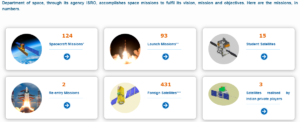Table of Contents
Indian Space Research Organisation (ISRO)
Indian Space Research Organisation, or ISRO, is the country of India’s space agency. It was established in 1969 to support the creation of an indigenous space project in India. The Department of Space of the Government of India oversees ISRO, a space agency with headquarters in Bengaluru, Karnataka. Its goal is to pursue planetary exploration, space science research, and national development via space technology. Antrix Corporation Limited (ACL), the marketing division of ISRO, is in charge of commercialising space products, providing technical consulting services, and transferring innovations created by ISRO.
Currently, ISRO is among the top six space agencies in the world. Through a network of centres, offices, and research institutes dispersed around the nation, ISRO serves the needs of the country by maintaining one of the largest fleets of remote sensing (IRS) and communication (INSAT) satellites in the world. Broadcasting, weather forecasting, disaster management, geographic information systems, navigation, cartography (maps), telemedicine, remote education satellites, and other services are all provided by ISRO.
Chandrayaan-3 Mission
Chandrayaan-3 is a follow-on mission to Chandrayaan-2 to demonstrate end-to-end capability in safe landing and roving on the lunar surface. LVM3 M4 vehicle successfully launched Chandrayaan-3 into orbit on July 14, 2023. Chandrayaan-3 successfully soft-landed on the south pole of the moon’s surface on August 23, 2023, and the Pragyaan Rover ramped down from the Vikram Lander and India took a walk on the moon on August 24, 2023. For detailed information about Chandrayaan-3 Mission click here.
Upcoming Missions of ISRO
The following are some of the upcoming ISRO Missions:
| Name | Details |
| Shukrayaan Mission | Following the successful launch of the Mars satellite, ISRO plans to launch a Venus satellite with the working name of Shukrayaan. |
| Own Space Station | ISRO intends to launch its first space station by 2030, joining China, Russia, and the US in the league. |
| XpoSat | ISRO created the space observatory XpoSat to examine cosmic X-rays. |
| Aditya L1 Mission | A satellite with a 1.5 million km (mile) range between Earth and the Sun is to be launched by the Indian Space Programme. |
| NISAR Mission | NASA-ISRO SAR (NISAR) is a Low Earth Orbit (LEO) observatory being jointly developed by NASA and ISRO. NISAR will map the entire globe in 12 days and provide spatially and temporally consistent data for understanding changes in Earth’s ecosystems, ice mass, vegetation biomass, sea level rise, groundwater and natural hazards including earthquakes, tsunamis, volcanoes and landslides |
Indian Space Research Organisation (ISRO) Background
Dr. Vikram Sarabhai, the man responsible for launching India’s space project in the 1960s, started space research activities there. Three main elements have been a part of the Indian space project from the beginning: communication and remote sensing satellites, the space transportation system, and application programmes.
Dr. Ramanathan and Dr. Sarabhai established INCOSPAR (Indian National Committee for Space Research). SITE, or Satellite Instructional Television Experiment, was run in 1975–1976. It was referred to as “the largest sociological experiment ever.” Following it was the “Kheda Communications Project (KCP),” which acted as a field laboratory for need-based and location-specific programme transmission in Gujarat.
The Department of Space was founded in 1972, although INCOSPAR was renamed the Indian Space Research Organisation in 1969 (now, ISRO is a division of the Department of Science). The following are the pivotal moments in ISRO history:
- The greatest sociological experiment ever done, SITE (Satellite Instructional Television Experiment), took place in 1975–1976.
- Gujarat is where the Kheda Communications Project was founded. The undertaking served as a field lab.
- In addition, ISRO created and launched Aryabhata, the first Indian spacecraft, utilising a Soviet launch vehicle.
- In 1980, SLV-3 made its maiden successful flight.
- Apple introduced the first satellite-based communication system.
- Antrix Corporation Limited (ACL), the ISRO’s marketing division, was established to advance and sell the use of space products.
- ISRO built a few specialised centres. These include the Vikram Sarabhai Space Centre (VSSC) and the Liquid Propulsion Systems Centre (LPSC) in Thiruvananthapuram, as well as the National Remote Sensing Centre (NRSC) in Hyderabad, the Space Applications Centre (SAC) in Ahmedabad, and the Satish Dhawan Space Centre (SDSC-SHAR) in Sriharikota.
ISRO Achievements
Since the Indian Space Research Organisation was founded, its employees have worked very hard to accomplish its goals. The following missions were successfully launched by ISRO:

Communication Satellites
With nine operational communication satellites in Geostationary orbit launched by the Indian Space Research Organisation (ISRO), the Indian National Satellite (INSAT) system, which went into service in 1983 with the commissioning of INSAT-1B, is one of the largest domestic communication satellite systems in the Asia-Pacific region.
The communications market in India underwent a significant transition as a result, which it sustained throughout time. The INSAT system supports telecommunications, satellite news gathering, television transmission, societal applications, weather forecasting, disaster warning, and search and rescue activities. Here are some of ISRO’s key communication satellites:
| Name of the Satellite | Launch Vehicle | Launch Date | Application |
| EDUSAT | GSLV-F01 / EDUSAT(GSAT-3) | Sep 20, 2004 | Communication |
| GSAT – 8 | Ariane-5 VA-202 | May 21, 2011 | Communication, Navigation |
| GSAT – 12 | PSLV-C17/GSAT-12 | Jul 15, 2011 | Communication |
| GSAT – 9 | GSLV-F09 / GSAT-9 | May 05, 2017 | Communication |
| GSAT – 19 | GSLV Mk III-D1/GSAT-19 Mission | Jun 05, 2017 | Communication |
| GSAT – 17 | Ariane-5 VA-238 | Jun 29, 2017 | Communication |
| GSAT – 6A | GSLV-F08/GSAT-6A Mission | Mar 29, 2018 | Communication |
| GSAT – 29 | GSLV Mk III-D2 / GSAT-29 Mission | Nov 14, 2018 | Communication |
| GSAT – 11 Mission | Ariane-5 VA-246 | Dec 05, 2018 | Communication |
| GSAT – 7A | GSLV-F11 / GSAT-7A Mission | Dec 19, 2018 | Communication |
| GSAT – 31 | Ariane-5 VA-247 | Feb 06, 2019 | Communication |
Earth Observation Satellites
Since the launch of IRS-1A in 1988, ISRO has launched a number of operational remote-sensing satellites. One of the largest satellite constellations for remote sensing is now run by India. Different instruments have been constructed and flown onboard to serve various national and international purposes in order to deliver the essential data at diversified temporal, spectral, and geographical resolutions. These satellites’ data are then utilised by ISRO for a variety of purposes, including disaster management, the management of ocean resources, forestry, environmental protection, mineral prospecting, rural development, urban planning, water resources, and agriculture.
The table below includes a list of ISRO’s significant Earth observation satellites, together with information about their launch vehicle and the date of launch:
| Name of the Satellite | Launch Vehicle | Launch Date | Application |
| Bhaskara-I | C-1 Intercosmos | Jun 07, 1979 | Earth Observation, Experimental |
| Rohini Satellite RS-D1 | SLV-3D1 | May 31, 1981 | Earth Observation |
| Oceansat (IRS-P4) | PSLV-C2/IRS-P4 | May 26, 1999 | Earth Observation |
| The Technology Experiment Satellite (TES) | PSLV-C3 / TES | Oct 22, 2001 | Earth Observation |
| CARTOSAT – 1 | PSLV-C6/CARTOSAT-1/HAMSAT | May 05, 2005 | Earth Observation |
| RISAT – 2 | PSLV-C12 / RISAT-2 | Apr 20, 2009 | Earth Observation |
| Oceansat – 2 | PSLV-C14 / OCEANSAT – 2 | Sep 23, 2009 | Climate & Environment, Disaster Management System |
| CARTOSAT – 2B | PSLV-C15/CARTOSAT-2B | Jul 12, 2010 | Earth Observation |
| RESOURCESAT-2 | PSLV-C16/RESOURCESAT-2 | Apr 20, 2011 | Earth Observation |
| Megha – Tropiques | PSLV-C18/Megha-Tropiques | Oct 12, 2011 | Climate & Environment, Disaster Management System |
| RISAT – 1 | PSLV-C19/RISAT-1 | Apr 26, 2012 | Earth Observation |
| SARAL | PSLV-C20/SARAL | Feb 25, 2013 | Climate & Environment, Disaster Management System |
| CARTOSAT-2 Series Satellite | PSLV-C34 / CARTOSAT-2 Series Satellite | Jun 22, 2016 | Earth Observation |
| INSAT-3DR | GSLV-F05 / INSAT-3DR | Sep 08, 2016 | Climate & Environment, Disaster Management System |
| SCATSAT-1 | PSLV-C35 / Cartosat-2 Series Satellite | Sep 26, 2016 | Climate & Environment |
| RESOURCESAT-2A | PSLV-C36 / Cartosat-2 Series Satellite | Dec 07, 2016 | Earth Observation |
| Cartosat-2 Series Satellite | PSLV-C37 / Cartosat-2 Series Satellite | Feb 15, 2017 | Earth Observation |
| Cartosat-2 Series Satellite | PSLV-C38 / Cartosat-2 Series Satellite | Jun 23, 2017 | Earth Observation |
| Cartosat-2 Series Satellite | PSLV-C40/Cartosat-2 Series Satellite Mission | Jan 12, 2018 | Earth Observation |
| HysIS | PSLV-C43 / HysIS Mission | Nov 29, 2018 | Earth Observation |
Navigation Satellites
The Airport Authority of India (AAI) and ISRO are collaborating to build the GPS Aided Geo Augmented Navigation (GAGAN) system in order to meet the requirements of Civil Aviation. Indian Regional Navigation Satellite System (IRNSS) is a regional satellite navigation system being established by ISRO in order to satisfy customer requirements for positioning, navigation, and timing services based on indigenous technology.
Experimental Satellites
Many small satellites, usually for research, have been launched by ISRO. This experiment makes use of payload development, orbit controls, atmospheric research, remote sensing, and recovery technology. The following is a list of the key experimental satellites that ISRO has launched:
| Name of the Satellite | Launch vehicle | Launch Date | Application |
| Aryabhata | PSLV-C40/Cartosat-2 Series Satellite Mission | Apr 19, 1975 | Experimental |
| Rohini Technology Payload (RTP) | PSLV-C16/RESOURCESAT-2 | Aug 10, 1979 | – |
| APPLE | Ariane-1(V-3) | Jun 19, 1981 | Communication, Experimental |
| YOUTHSAT | SLV-3E1 | Apr 20, 2011 | Student Satellite |
| INS-1C | C-1 Intercosmos | Jan 12, 2018 | Experimental |
Small Satellites
The small satellite project will soon offer a platform for standalone payloads for science and earth imaging missions. The Indian Space Research Organisation (ISRO) has developed two different bus types, the Indian Mini Satellite -1 (IMS-1) and Indian Mini Satellite – 2 (IMS-2), to offer a versatile platform for different payloads.
Here is a list of the small satellites that ISRO has launched:
| Name of the Satellite | Launch Vehicle | Launch Date | Application |
| YOUTHSAT | PSLV-C16/RESOURCESAT-2 | Apr 20, 2011 | Student Satellite |
| Microsat | PSLV-C40/Cartosat-2 Series Satellite Mission | Jan 12, 2018 | Experimental |
Space Science & Exploration Satellites
Satellites fall within this group: The first dedicated Indian astronomy mission, AstroSat, studies celestial sources simultaneously in the X, optical, and UV spectral bands. The true first interplanetary mission of ISRO, the Mars Orbiter Mission (MOM), was launched on November 5, 2013. Both Chandrayaan-1 and Chandrayaan-2, India’s first and second moon missions, included an orbiter, a lander, a rover, and other components.
Academic Institute Satellites
Educational institutions have been impacted by ISRO operations, such as the development of connectivity, remote sensing, and astronomy satellites. Universities and other organisations have been more interested in creating experimental student satellites as a result of the Chandrayaan-1 launch.
Here is a table listing the ISRO-launched academic institute satellites:
| Satellite Name | Launch Vehicle | Launch Date |
| ANUSAT | PSLV-C12 / RISAT-2 | Apr 20, 2009 |
| STUDSAT | PSLV-C15/CARTOSAT-2B | Jul 12, 2010 |
| Jugnu | PSLV-C18/Megha-Tropiques | Oct 12, 2011 |
| SWAYAM | PSLV-C34 / CARTOSAT-2 Series Satellite | Jun 22, 2016 |
| SATHYABAMASAT | PSLV-C34 / CARTOSAT-2 Series Satellite | Jun 22, 2016 |
| PRATHAM | PSLV-C35 / SCATSAT-1 | Sep 26, 2016 |
| Kalamsat-V2 | PSLV-C44 | Jan 24, 2019 |
Scramjet (Supersonic Combusting Ramjet) Engine
The Supersonic Combusting Ramjet Engine Test, or Scramjet, was successfully completed by ISRO in August 2016. The fuel for the Scramjet engine is hydrogen, while the oxidizer is oxygen from the surrounding air. With a longer flight time, the new propulsion system will enhance ISRO’s reusable launch vehicle.
Indian Space Research Organisation (ISRO) Objective
ISRO has the ambition to develop space technology for the benefit of the country and to conduct planetary exploration and space science research. The following are the main goals of ISRO:
- The Small Satellite Launch Vehicle (SSLV), Geosynchronous Satellite Launch Vehicle (GSLV), and Polar Satellite Launch Vehicle (PSLV) operational flights.
- To plan, create, and launch communication and earth observation satellites.
- Designing and developing fresh approaches to space transportation is another important goal of ISRO.
- To create satellites for planetary exploration and space science, as well as satellite navigation systems.
- To create tools for more accurate earth observation.
- To develop a system based on space for use in society.
- Developing proper training, education, and capacity-building programmes for students interested in space technology is one of ISRO’s main goals.
Indian Space Research Organisation (ISRO) Challenges and Opportunities
Even though ISRO’s success stories are celebrated all over the world, the organisation still faces obstacles in accomplishing its objectives. The Indian Space Programme has the following problems and opportunities:
- India is not in a situation where it is facing specific security and development concerns since it is a developing nation. For instance, ISRO is called into question and forced to defend the funding for missions that need a lot of work but have little to do with development.
- Since China tested an anti-satellite missile (ASAT) in 2007, the country has upped the threat level. In addition to the one on the ground, it can start in space. There have been military weaknesses since India relied on satellites like MOM.
- The US or other nations must cooperate with the DRDO while it develops a missile.
- China launched the satellite in 2011 and 2012 to target Pakistan and Sri Lanka.
Indian Space Research Organisation (ISRO) UPSC
One of the most significant scientific institutions in the nation and a recent boon to India is ISRO. The ISRO-launched satellites have been successful in gathering the needed information, making them a crucial component of India’s development. Being so important for the nation, it is also a key subject for UPSC hopefuls because many questions from the ISRO UPSC notes are asked in the IAS Exam.


 Genetically Modified Crops in India, Reg...
Genetically Modified Crops in India, Reg...
 What are Polycyclic Aromatic Hydrocarbon...
What are Polycyclic Aromatic Hydrocarbon...
 MALE Class Drones: Capabilities, Payload...
MALE Class Drones: Capabilities, Payload...





















